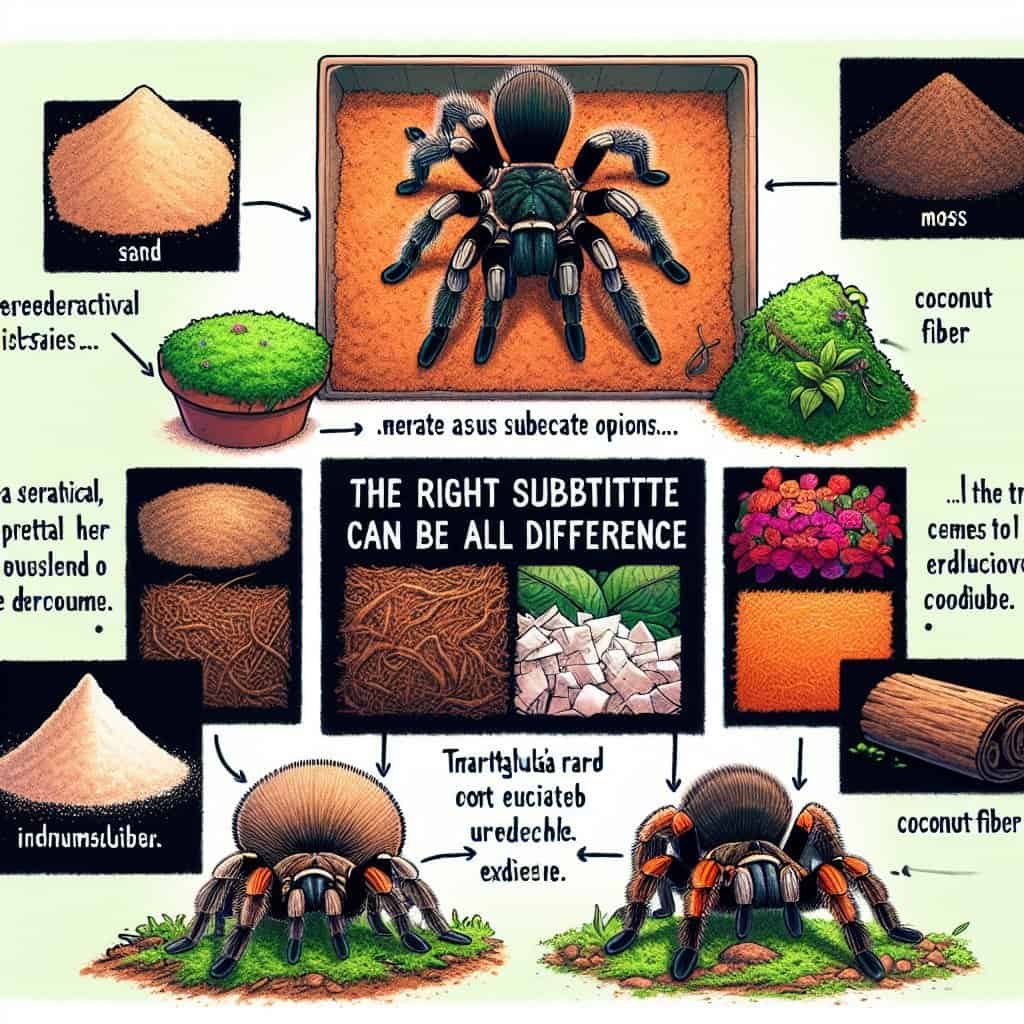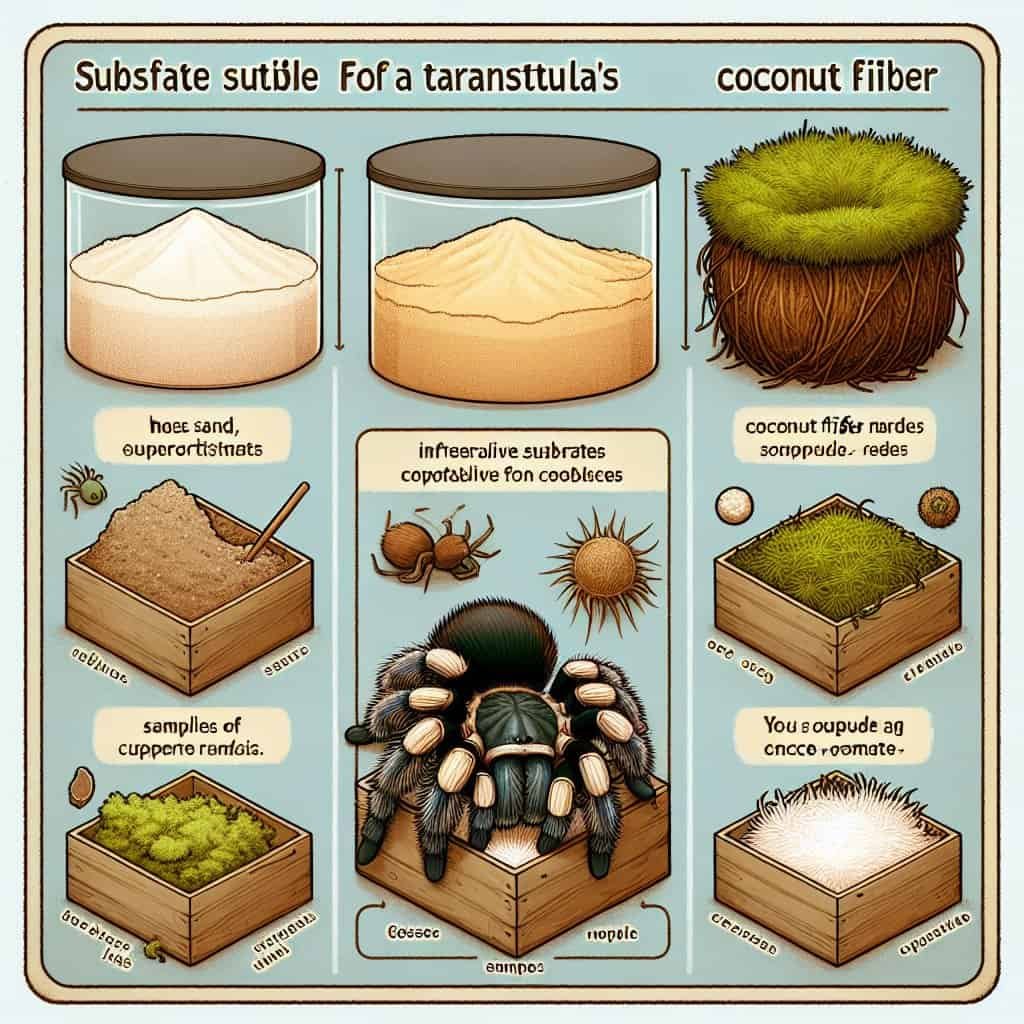If you’ve recently adopted a tarantula and find yourself unsure about the ideal substrate for its enclosure, fear not! Finding the perfect bedding for your eight-legged friend is essential for creating a comfortable and safe living environment. From sand to peat moss, this article explores various substrate options, comparing their benefits and drawbacks. By the end, you’ll have a clearer understanding of what type of substrate would be best suited for your tarantula’s habitat, ensuring a happy and healthy home for your new creepy-crawly companion.
Introduction
Choosing the right substrate for your tarantula enclosure is crucial for maintaining a healthy and suitable environment for your pet. The substrate not only serves as a base for your tarantula to walk and burrow on but also plays a vital role in regulating humidity levels and maintaining a natural habitat. With various options available, it’s important to understand the benefits and considerations of each substrate type to make an informed decision. In this article, we will explore different types of substrates commonly used for tarantula enclosures and guide you on how to prepare and use them effectively.
Soil-based Substrates
Benefits of soil-based substrates
Soil-based substrates are widely used due to their natural composition that closely resembles the tarantulas’ natural habitat. They provide a secure and comfortable environment for your pet to burrow, explore, and exhibit their natural behavior. Soil-based substrates also retain moisture well, aiding in maintaining the optimal humidity levels required for most species of tarantulas.
Types of soil-based substrates
When selecting a soil-based substrate, consider organic potting soil or topsoil without any additives, such as vermiculite or perlite. This ensures that the substrate remains safe for your tarantula, without introducing potentially harmful elements. It’s recommended to avoid using garden soil, as it may contain pesticides or fertilizers that can be harmful to your pet.
Preparing and using soil-based substrates
Before adding the soil-based substrate to the enclosure, it is advisable to bake it in the oven at a low temperature to eliminate any potential pests or bacteria. Allow it to cool before placing it in the enclosure. The substrate should be at least three inches deep to provide sufficient depth for burrowing. Regularly check the moisture levels by pressing the substrate lightly; it should be slightly damp but not overly wet.

Coco Fiber (Coir)
Advantages of coco fiber as a substrate
Coco fiber, or coir, is an increasingly popular choice for tarantula enclosures due to its excellent water retention properties. It retains moisture well, allowing for the creation of a suitable microclimate for your tarantula. Coco fiber is also free from pests, molds, and other potential contaminants, making it a safe option for your pet. Additionally, it is environmentally friendly and sustainable, as it is derived from coconut husks.
Preparation and application of coco fiber
To prepare coco fiber as a substrate, soak it in water to rehydrate it and then squeeze out any excess water. Fluff it up to create a loose and soft texture before placing it in the enclosure. The substrate should be approximately three inches deep to allow for digging and burrowing. Mist the enclosure occasionally to maintain the desired humidity level, as coco fiber tends to dry out more quickly than other substrates.
Considerations when using coco fiber
While coco fiber offers many advantages as a substrate, it is worth noting that it can be slightly acidic. Some tarantula species may prefer a more neutral pH level, so it’s important to monitor the behavior and health of your tarantula carefully. If you notice any signs of stress or discomfort, you may consider mixing coco fiber with other neutral substrates to achieve a more balanced pH level.
Peat Moss
Benefits of peat moss
Peat moss is a commonly used substrate for tarantula enclosures due to its exceptional water retention capabilities. It provides a humid environment, which is beneficial for tarantulas that require higher moisture levels. Peat moss also promotes burrowing and mimics the natural forest floor, allowing your tarantula to exhibit natural behaviors.
Using peat moss as a substrate
To use peat moss, simply place it in the enclosure at a depth of around three inches. Ensure that the peat moss is moist but not waterlogged. It’s crucial to monitor the moisture level and adjust accordingly, as excessive moisture can lead to mold growth or bacterial contamination. Mist the enclosure regularly to maintain the desired humidity level.
Moisture considerations with peat moss
While peat moss effectively retains moisture, it can become compacted over time. Fluffing the substrate periodically can help maintain air circulation and prevent excessive compaction. Additionally, it’s important to strike a balance between moisture and ventilation to prevent stagnant air and the growth of harmful bacteria. Ensure proper ventilation in the enclosure to avoid any respiratory issues for your tarantula.

Vermiculite
Advantages of vermiculite as a substrate
Vermiculite is a lightweight and highly absorbent substrate that holds moisture well. It helps create a stable environment for your tarantula, ensuring adequate humidity levels. Vermiculite also provides insulation, keeping the enclosure warm during colder months. Its lightweight nature makes it easy to work with and promotes natural burrowing behavior.
How to use vermiculite
When using vermiculite, dampen it with water before placing it in the enclosure. A depth of one to two inches is sufficient for most tarantula species. The substrate should be regularly misted to maintain a consistent level of humidity. Vermiculite can also be mixed with other substrates, such as coco fiber or peat moss, to create a well-balanced environment.
Potential concerns with vermiculite
It’s important to note that vermiculite can be dusty, which may pose respiratory risks to both you and your tarantula. Ensure proper ventilation in the enclosure and avoid excessive stirring or disturbing of the substrate that may release dust particles. Regularly monitor your tarantula for any signs of respiratory distress and consult a veterinarian if necessary.
Sand
Pros and cons of using sand as a substrate
Sand is a popular choice for desert-dwelling tarantulas, as it replicates their natural habitat. It provides a firm and stable surface for walking and allows for easy burrowing. Sand is also visually appealing and allows for naturalistic setups. However, it’s important to note that fine sand can pose a risk of impaction if ingested by your tarantula.
Precautions when using sand
When using sand as a substrate, it’s crucial to provide a shallow water dish to prevent dehydration. Ensure that the sand is moist but not waterlogged, as excessive moisture can lead to mold growth or bacterial contamination. Regularly monitor the moisture levels to ensure they are suitable for your tarantula’s needs.
Mixing sand with other substrates
To reduce the risk of impaction, some tarantula owners prefer to mix sand with other substrates, such as coco fiber or peat moss. This creates a more balanced substrate and helps prevent the sand from clumping or becoming too compacted. Experiment with different ratios to find the combination that works best for your tarantula’s needs.

Eco Earth
Benefits of Eco Earth
Eco Earth, a type of compressed coconut fiber, is an excellent substrate option for tropical tarantula species. It provides a naturalistic appearance and offers good water retention, crucial for maintaining the necessary humidity levels. Eco Earth is also mold-resistant and free from harmful chemicals, making it a safe choice for your tarantula.
Application and maintenance of Eco Earth
To use Eco Earth, simply soak the compressed brick in water and allow it to expand. Fluff up the substrate and place it in the enclosure at a depth of around three inches. Monitor the humidity levels and mist the enclosure regularly to maintain the desired moisture content. Eco Earth should be replaced periodically to prevent the buildup of mold or bacteria.
Misting considerations with Eco Earth
Eco Earth tends to dry out more quickly than some other substrates, so misting is necessary to maintain the desired humidity levels. However, be cautious not to oversaturate the substrate, as excessive moisture can lead to mold or bacterial growth. Regularly assess the moisture levels and adjust the misting routine accordingly.
Orchid Bark
Advantages of using orchid bark as a substrate
Orchid bark is a natural and visually appealing substrate option that replicates the forest floor habitat of many tarantula species. It promotes natural behaviors such as burrowing and provides a well-draining environment. Orchid bark is also resistant to mold and fungal growth, ensuring the overall health of your tarantula.
Preparing and using orchid bark
To prepare orchid bark for use, soak it in water for a few hours to remove any dust or debris. Allow it to drain thoroughly before placing it in the enclosure. Orchid bark should be spread at a depth of around three inches to provide ample substrate for burrowing. Regularly monitor the moisture levels and mist as needed to maintain the desired humidity.
Potential drawbacks of orchid bark
While orchid bark offers numerous benefits, it’s essential to consider the size of the tarantula species you are keeping. Smaller tarantulas may struggle to move efficiently on the larger pieces of bark. In such cases, you may need to crush or break the bark into smaller pieces to provide a more suitable substrate.

Leaf Litter
Benefits of using leaf litter
Using leaf litter as a substrate in your tarantula enclosure adds an extra element of naturalism and enrichment for your pet. Leaf litter creates a suitable hiding spot and promotes the tarantula’s natural behavior of hunting and exploring. It also aids in maintaining humidity levels and provides a soft surface for walking and burrowing.
Collecting and preparing leaf litter
When collecting leaf litter, ensure that it is free from pesticides, toxins, or any potential contaminants. Collect leaves from non-toxic trees or purchase prepackaged leaf litter from reputable sources. Before adding it to the enclosure, bake the leaf litter in the oven at a low temperature to eliminate any potential pests or bacteria. Allow the leaves to cool before placing them in the enclosure.
Replacing leaf litter regularly
Leaf litter should be replaced regularly to prevent the buildup of mold, fungus, or bacteria. Removing any soiled or decomposed leaves helps maintain a clean and healthy environment for your tarantula. When adding new leaf litter, be sure to spread it evenly throughout the enclosure to provide ample hiding spots and enrichment opportunities for your pet.
Conclusion
Choosing the right substrate for your tarantula enclosure is essential for creating a suitable and comfortable habitat. Consider the natural habitat of your tarantula species and its specific needs when selecting a substrate. Whether it’s soil-based substrates, coco fiber, peat moss, vermiculite, sand, Eco Earth, orchid bark, or leaf litter, each substrate offers unique advantages and considerations. By understanding the benefits and preparing and maintaining the substrate effectively, you can provide your tarantula with a safe and enriching environment to thrive in. Remember to regularly monitor and adjust the conditions to ensure your tarantula’s health and well-being.

